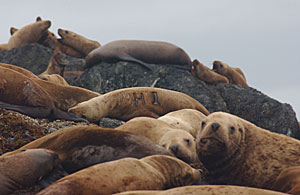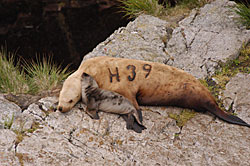Steller Sea Lion Research
Population Vital Rates
In Alaska, Steller sea lions range from southeastern Alaska north and west through the Gulf of Alaska, along the Aleutian Islands chain and into the Bering Sea. They are currently listed as endangered in their western Distinct Population Segment (wDPS) and have been delisted from their former threatened status in their eastern DPS. These populations are divided at Cape Suckling, Alaska, which lies between Prince William Sound and Yakutat. In the wDPS, sea lion numbers declined between the 1970s and 1990s. The overall decline ceased in 2000-2003, with modest increases east of Samalga Pass while declines continued to the west. Meanwhile the eDPS has steadily increased at approximately 3% per year.

The ADF&G Steller Sea Lion Program works closely with the National Marine Fisheries Service Marine Mammal Laboratory (MML) to estimate vital rates of Steller sea lions, in particular, age-specific survival and reproductive rates. By comparing survival and reproductive rates between these regions of differing population trends we hope to identify factors that help explain these differing trends.

ADF&G, MML and the Alaska SeaLife Center have permanently marked, by hot-branding under anesthesia, sea lions for individual identification at rookeries throughout Alaska. Every summer, these agencies follow up on this work by conducting brand-resight cruises during which nearly every sea lion haulout and rookery in Alaska is visited by biologists in small skiffs. We resight animals during other seasons for specific projects or opportunistically during other types of fieldwork. During these skiff and land-based surveys, biologists conduct counts, photograph branded animals, and collect behavioral data (for example, whether a female has a nursing pup or an adult male is defending a territory). Resightings of branded individuals are used in mark-recapture models to estimate survival, reproductive rates,the age of weaning and other life history variables.
To date our database of resighted animals exceeds 57,000 observations, confirmed using photographs, of 3,300 branded animals.
Publications
- Hastings, K. K., D. S. Johnson, G. W. Pendleton, B. S. Fadely and T. S. Gelatt. 2021. Investigating life history traits of Steller sea lions with multistate hidden Markov mark-recapture models: age at weaning and body size effects. Ecology and Evolution 11:714-734.
- Hastings, K. K., M. J. Rehberg, G. M. O'Corry-Crowe, G. W. Pendleton, L. A. Jemison and T. S. Gelatt. 2020. Demographic consequences and characteristics of recent population mixing and colonization in Steller sea lions Eumetopias jubatus. Journal of Mammalogy 101: 107-120.
- Jemison, L. A., G. W. Pendleton, K. K. Hastings, J. M. Maniscalco and L. W. Fritz. 2018. Spatial distribution, movements, and geographic range of Steller sea lions (Eumetopias jubatus) in Alaska. PLoS ONE 13: e0208093.
- Hastings, K. K., L. A. Jemison and G. W. Pendleton. 2018. Survival of adult Steller sea lions in Alaska: senescence, annual variation and covariation with male reproductive success. Royal Society Open Science 5: 170665.
- Hastings, K. K., D. S. Johnson and T. S. Gelatt. 2018. Flipper tag loss in Steller sea lions. Marine Mammal Science 34: 229-237.
- Hastings, K. K., L. A. Jemison, G. W. Pendleton, K. L. Raum-Suryan and K. W. Pitcher. 2017. Natal and breeding philopatry of female Steller sea lions in southeastern Alaska. PLoS ONE 12: e0176840.
- Hastings, K. K. 2017. Survival of Steller sea lion (Eumetopias jubatus) pups during the first months of life at the Forrester Island complex, Alaska. Journal of Mammalogy 98: 397-409.
- Pendleton, G. W., K. K. Hastings, L. D. Rea, L. A. Jemison, G. M. O'Corry-Crowe and K. B. Beckmen. 2016. Short-term survival of Steller sea lion (Eumetopias jubatus) pups: Investigating the effect of health status on survival. Marine Mammal Science 32: 931-944.
- Hastings, K. K. and L. A. Jemison. 2016. Age-specific variation in timing of parturition in Steller sea lions at Forrester Island Complex, Alaska. Marine Mammal Science 32: 777-785.
- Jemison, L. A., G. W. Pendleton, L. W. Fritz, K. K. Hastings, J. M. Maniscalco, A. W. Trites and T. S. Gelatt. 2013. Inter-population movements of Steller sea lions in Alaska with implications for population separation. PloS ONE 8: e70167.
- Hastings, K. K., L. A. Jemison, T. S. Gelatt, J. L. Laake, G. W. Pendleton, J. C. King, A. W. Trites and K. W. Pitcher. 2011. Cohort effects and spatial variation in age-specific survival of Steller sea lions from southeastern Alaska. Ecosphere 2: art111.
- Hastings, K. K., T. S. Gelatt, and J. C. King. 2009. Postbranding survival of Steller sea lion pups at Lowrie Island in Southeast Alaska. Journal of Wildlife Management 73(7):1040-1051. DOI: 10.2193/2007-208.
- Kaplan, C. C., G. C. White, and B. R. Noon. 2008. Neonatal survival of Steller sea lions (Eumetopias jubatus). Marine Mammal Science, 24(3):443-461.
- Pendelton, G. W., Pitcher, K. W., Fritz, L. W., York, A. E., Raum-Suryan, K. L., Loughling, T. R., Calkins, D. G., Hastings, K. K. and Gelatt, T. S. 2006. Survival of Steller sea lions in Alaska: a comparison of increasing and decreasing populations. Canadian Journal of Zoology 84: 1163-1172.
- Pitcher, K. W., Burkanov, V. N., Calkins, D. G., Le Boeuf, B. J., Mamaev, E. G., Merrick, R. L., and Pendleton, G. W. 2001. Spatial and temporal variation in the timing of births of steller sea lions. Journal of Mammalogy 82(4): 1047-1053.
- Pitcher, K., Olesiuk, P., Brown, R., Lowry, M., Jeffries, S., Sease, J., Perryman, W., Stinchcomb, C., and Lowry, L. 2007. Abundance and distribution of the eastern North Pacific Steller sea lion (Eumetopias jubatus) population. Fishery Bulletin. 107: 102-115.
- Raum-Suryan, K. L., Pitcher, K. W., Calkins, D. G., Sease, J. L., and Loughlin, T. R. 2002. Dispersal, rookery fidelity, and metapopulation structure of Steller sea lions (Eumetopias jubatus) in an increasing and a decreasing population in Alaska. Marine Mammal Science 18(3): 746-764.
Contact the ADF&G Steller Sea Lion Program at dfg.dwc.sealions@alaska.gov.
How to Report Branded Sea Lion Sightings

If you see a branded sea lion, we'd like to hear from you! Photographs of the sea lion and its brand, the date, and location are very valuable pieces of information that we can use. Photographs of branded sea lions that are entangled by marine debris, suckling their pups or nursing from their mothers are also valuable.
Please keep in mind the Marine Mammal Protection Act prohibits anyone from disturbing marine mammals unless authorized by NOAA permit, and it is wise to keep a distance of 100 yards between yourself and sea lions on their haulouts.
Please send photos along with date, specific location, and your contact information to dfg.dwc.sealions@alaska.gov. Thank you!
To report an injured or dead marine mammal: please call the National Marine Fisheries Service Alaska 24 hr Stranding Hotline: (877) 925-7773 or (877) 9-AKR-PRD.
